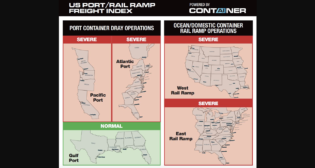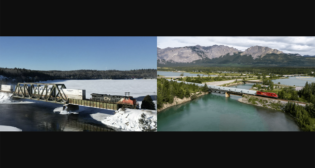
The crude oil challenge
Written by Bruce E. Kelly, Contributing EditorCrude by rail is not entirely new. Railway cars were first developed for the shipment of oil out of Pennsylvania as early as 1865. By 1910, sets of crude-laden tank cars were routinely moving between wells and refineries in Asia, the Middle East, and much of the Western world. In the 1980s, unit train service was started between central California and a refinery outside Los Angeles, with 70 or more cars handling in excess of 40,000 barrels of crude per trip.
What is new is the enormous scale of volume and distance. In 2009, U.S. Class I railroads moved just under 11,000 carloads of crude. In 2011, that number increased to more than 65,000 carloads. Then came 2012, when U.S. railroads hauled some 235,000 carloads of crude, a feat made possible in part through increased use of hydraulic fracturing, or “fracking” (which has tapped vast supplies of previously unreachable shale oil), and also through the increased use of unit trains that are dedicated to handling crude.
Year-end estimates show U.S. railroads transported close to 400,000 carloads of crude in 2013. And the majority of those shipments are traveling 1,200 miles or more, by rail, from the heartland of North America outward to refineries and terminals on the Pacific, Atlantic, and Gulf coasts, locations that have traditionally been supplied by pipelines, offshore wells, or by tanker ships delivering crude from Alaska or foreign sources.
Pipelines on rails
Some have pointed to President Obama’s decision not to approve the Keystone XL pipeline as being the catalyst for the energy sector’s rush toward CBR. That pipeline, a portion of which remains under review, would deliver Canadian oil to markets in the central and southern U.S. But at 1,179 miles and a price tag of $5.4 billion, Keystone XL will not be ready any time soon. In December 2013, one of its potential customers announced it was already shipping 90% of its crude by rail. Likewise, a 740-mile, $2 billion pipeline that Kinder Morgan planned to build from Texas to California was cancelled after refineries chose to increase their use of crude delivered by rail.
In addition to the oil-rich Bakken shale/Williston Basin area of North Dakota and eastern Montana, CBR has tapped numerous other crude oil sources, the largest of those being the Marcellus shale formation in the Northeastern U.S., the Eagle Ford formation in southern Texas, and the Permian Basin in west Texas and New Mexico, as well as the oil sands of western Canada. Railroads already had the basic route structure in place to connect this new generation of oil producers with their customers. By investing millions of dollars in new transloading facilities, energy companies and railroads accomplished in a matter of months what it would have taken pipelines several years, and billions of dollars, to do.
In North Dakota’s Bakken alone, no less than 18 separate CBR loading facilities were operating as of 2013. In June 2013, a study by Bloomberg Industries said that 71% of Bakken crude production was shipping out by rail, up from 25% in early 2012. BNSF Railway, which has been at the forefront of Bakken CBR, offers the most rail loading capacity in the Williston Basin through service from 11 originating terminals. In all, BNSF serves more than 30 CBR loading facilities across its system.
Destinations for CBR include rail-to-barge terminals on the Mississippi River, as well as refineries and terminals on or near the Gulf Coast. However, CBR destinations on the East and West coasts have presented economic advantages, according to oil industry data published last year. Crude from as far west as Utah’s Uinta Basin was shipped by rail to the East Coast in 2013. That delivery of 250,000 barrels was minor compared to the 38 million barrels—mostly from the Bakken—that moved by rail through Albany, N.Y., alone.
CSX moved more than 46,000 carloads of crude oil in 2013, compared with fewer than 10,000 carloads in 2012. As for destinations, CSX serves existing unit train terminals in Albany, N.Y.; Westville, N.J.; Eddystone, Pa.; Yorktown, Va.; and Walnut Hill, Fla.; and refineries in Philadelphia, Pa., and Saint John, New Brunswick, Canada.
Norfolk Southern moves crude oil across its rail network in both unit train and manifest service to serve the Northeast (its largest customer, PBF Energy, built two unit train unloading tracks at its Delaware City, Del., refinery in early 2013), Gulf Coast, and Mid-Continent (Illinois/Indiana) refining markets. The railroad exchanges unit trains outside Chicago, and delivers to refinery customers in the Northeast and Mid-Atlantic. Its Mid-Continent service involves delivering crude to terminals for ultimate delivery via barge to refineries on the Mississippi River. For north-south movements, NS works with interline rail partners to transport heavy crude oil from Canadian shale fields to U.S. refineries on the Gulf and East coasts.
“We offer the shortest and most direct route to the East Coast,” NS says. “Our crude network is very resilient due to the existence of multiple tracks and large, evenly distributed rail yards capable of staging unit trains. We operate parallel routes on 91% of our network, providing even additional resiliency. We’ve made track improvements to accommodate crude traffic growth, and refineries are investing in plant expansions. For third-quarter 2013, we moved the equivalent of two unit trains (about 200 cars) per day, the largest absolute volume share for an East Coast rail carrier. But we still have adequate capacity to grow crude by rail volumes.”
Current market fundamentals and demand suggest that the crude oil business will grow well beyond current levels.
The West is arguably where CBR’s star shines brightest. North Dakota is second only to Texas for U.S. oil production, but North Dakota is the largest and fastest-growing source of CBR in the U.S. There are no pipelines to adequately compete with rail for shipment of Bakken crude to Pacific region terminals. The cost for shipping Bakken crude by rail during 2013 hovered near $10 a barrel for Northwest destinations, $14 per barrel to California, but was up around $17 per barrel for the East Coast. Correspondingly, there are more than a dozen locations between California and the Pacific Northwest where receiving facilities are either in full operation, are undergoing expansion for CBR, or are on the drawing board.
Among its western destinations, BNSF delivers unit crude trains to refineries at Anacortes and Tacoma, Wash., as well as Richmond and Bakersfield, Calif. It also interchanges unit crude to short line Portland & Western for delivery to a distribution terminal near Clatskanie, Ore. An existing BP refinery at Cherry Point, Wash., will likely have the next West Coast unit train terminal to go on line. New unit train receiving tracks were in place at Cherry Point as of late 2013, with operation expected to begin in 2014.
Union Pacific tells Railway Age, “Our largest origin [for CBR] is the Bakken formation in North Dakota served by BNSF and Canadian Pacific. Through partnership with those two companies, we’re able to deliver Bakken crude to several on-line customers. Our flagship destination is St. James, La. There are two terminals in St. James and both facilities handle multiple trains per day.” System-wide, UP says it moves approximately three to five loaded unit crude trains per day. UP is tapping new crude sources outside the Bakken as well. It handled the first train departing the new terminal in Pronghorn, Wyo., in late December. This facility will serve the growing Niobrara shale area.
Canada to California, and coast to coast
Union Pacific is also increasing its unit train and manifest deliveries of crude to refineries in California. UP began hauling blocks of CBR south from Canada into California during 2013. Valero Energy, whose tank cars are transporting that Canadian crude, announced last year that it plans to enlarge its Benicia, Calif., terminal to accommodate unit trains. Valero’s Benicia rail offloading facility is undergoing an environmental impact study, which should be completed soon. Once it is complete, the city of Benicia can proceed with the project evaluation process.
CBR represents a small (less than 5%) but rapidly growing segment of California’s oil imports. Crude from North Dakota, via BNSF and UP, accounted for roughly 40% of the oil being delivered to California by rail in 2013. That figure may not include oil that was moved by rail to Northwest ports then brought south along the Pacific Coast by barge.
Canadian Pacific and CN deliver crude to terminals in the U.S. as well as Canada, and they’re hauling it from two distinctly different sources: Bakken shale and oil sands. Between 2009 and 2012, CP went from moving 500 carloads of crude per year to more than 53,000 per year. Through 2013’s first three quarters, CP moved 65,000 carloads of crude, and predicted that year-end totals would reach 85,000-90,000 carloads. CN estimates its crude carloads for 2013 exceeded 65,000, up from roughly 35,000 in 2012.
What sets Canada apart from the U.S. is export policy. Since the OPEC energy crisis of the 1970s, the U.S. has banned nearly all crude exports (with limited exceptions for crude from Alaska and California) to all countries except Canada. The oil industry and others are now lobbying for a repeal of that ban. For now, railroads can only deliver U.S. crude to refineries and distribution terminals in the U.S. or Canada. CBR originating in Canada, however, can be moved directly to export docks. OmniTRAX subsidiary Hudson Bay Railway plans to begin moving Canadian crude to an export terminal at Churchill, Man., by mid-2014.
The road ahead
For North America’s railroads, crude-by-rail could not have come at a better time. As BNSF CEO (now Executive Chairman) Matt Rose told Railway Age in mid-2013, “CBR is backfilling 50% of our coal loss, and we are allocating a significant amount of capital to our Northern corridor for CBR.” During 2013, BNSF spent $220 million on CBR-related infrastructure in North Dakota, and it’s also investing in capacity improvements from there to the Pacific Northwest. BNSF has been running one to three loaded crude trains per day into the Northwest. That number should increase once Cherry Point’s unit CBR terminal opens.
CBR-related capacity improvements are also happening at UP, including roughly $200 million for its route leading to St. James, La. And at CSX, CBR business benefits from a capacity expansion project along the River Line between Albany, N.Y., and northern New Jersey. In 2013, CSX spent $26 million double-tracking 18 more miles of this line. Global Partners, which operates a CBR terminal in Albany, could bring optional crude capability to the Northeast through its proposed rail-to-barge terminal on the Hudson River at New Windsor, N.Y.
CBR has made even bigger headlines following recent accidents in which tank cars carrying crude exploded or caught fire, following derailments—all of which were from different causes. Statistically, these incidents were an anomaly when compared with U.S. Department of Transportation figures cited by the AAR. U.S. railroads had fewer than 150 incidents during 2002-2012 involving releases of crude, with 2,300 barrels spilled. U.S. pipelines during that same 10 -year period had 1,785 incidents, which spilled an estimated 474,000 barrels. A single pipeline leak this past September went unnoticed for days and spilled some 21,000 barrels of crude across seven acres of a North Dakota wheat field.
Those figures provide little consolation for the 47 lives lost in a CBR-related disaster in Quebec last July. Nor do they address the surprisingly volatile nature of crude coming from Bakken shale, something the rail industry, DOT, and other agencies are now committed to resolve. Tank car builders are now gearing up to meet demand for safety-first equipment, and the current construction boom could accelerate as older equipment is phased out or retrofitted, as Editor-in-Chief William C. Vantuono describes.
In the coming year, the geopolitical and environmental aspects of oil could weigh more heavily on railroads than ever before. At the same time, railroads are proving capable of meeting unprecedented demand for transporting affordable energy to national and global markets.



